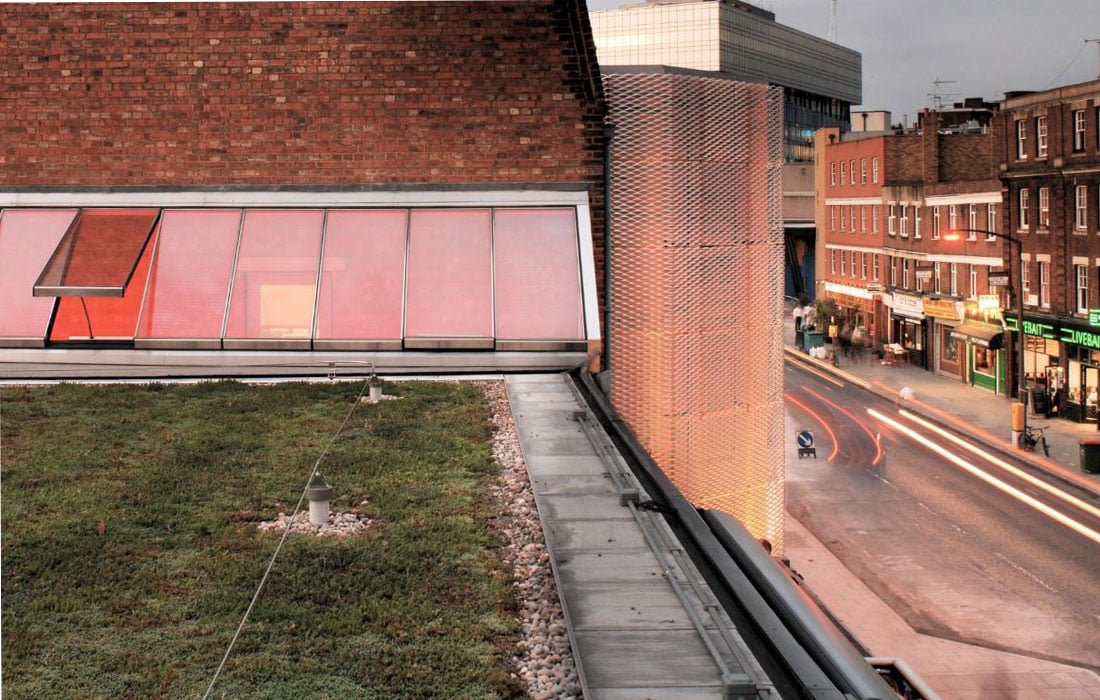
The sedum roof at the Young Vic, part of the passive low energy rebuilding project by Haworth Tompkins
Photo: © Philip Vile
A major blind spot
Very few theatres were built with today's sustainability standards in mind. The sector needs to face up to the financial and environmental costs of running old buildings, warns Tom Stickland.
Theatre, like the rest of the arts, usually considers itself to be a socially responsible sector – and there is no bigger social issue right now than protecting the environment. Plastic-free venues, paperless ticketing and a commitment to recycling and reuse are all now commonplace in theatre.
From sedum rooves to new windows, from building management systems to more efficient water heaters, we will be supporting a range of projects
But for all the cutting back on plastic use and reduced waste, there is a major blind spot. The issue that is rarely talked about is the condition of the theatre buildings themselves. While operational changes can make a difference in reducing energy wastage and carbon footprint, buildings, and the plant that services them, are in need of investment to make them more efficient. In our recent survey of theatres planning capital works in the next five years, 50% cited environmental improvements as one of the reasons for the works.
Energy efficiency
The UK has a remarkable stock of over a thousand active theatres, ranging from the Georgian to the modern – but very few built with today’s environmental standards in mind. We are aware that some theatres have implemented innovative, vital works to make improvements, but given the scale and urgency of the issue, much more needs to be done.
Major energy consumption comes from heating, ventilation and stage machinery. Modern-day audiences also have a higher level of expectation when it comes to comfort, increasing the use of mechanical services. Ventilation plants consume a lot of energy as they drag air around a building, but with quality design there are alternative low-energy solutions.
Hull Truck Theatre has a passive ventilation system that includes using the natural heat from the audience to warm the air as it circulates through the auditorium. The Watermill Theatre in Newbury uses geothermal energy to regulate its temperature. The boreholes around the theatre serve as a heat source in the winter and a heat sink in the summer months.
Theatre lighting
It is not just heating systems: types of lighting can have a big impact too. The industry was brought to the brink of a crisis last year when eco-design regulations threatened the existing lighting stock in our theatres. It was temporarily averted thanks to the work of many bodies coordinated by the Association of Lighting Designers, but it was a wake-up call to address the issue.
The technology does not exist yet for a full replacement of conventional theatre lighting with LED alternatives, but replacing wherever possible future-proofs theatres against changes in legislation and significantly reduces the impact and electricity bills for theatres. The Lyric Hammersmith in London (see this issue's case study) is an example of a theatre that is switching to LED fixtures whenever possible when replacing older lighting stock.
Sustainable building practices
Building works make a large environmental impact, but sustainable building practices can support a green identity for the organisation and also contribute to a building’s character. The Arcola Theatre in London salvaged materials to be used in its new building and is aiming to be the first carbon neutral theatre. It has fitted solar panels, a carbon-neutral boiler, solar thermal panels, LED lighting and DC microgrids.
Tara Arts, also in London, included solar electricity technology in its recent building works – helping reduce energy costs – and its auditorium seating has been recycled from the RSC’s temporary Courtyard Theatre. The Liverpool Everyman salvaged the bricks from its previous building when constructing its award-winning new theatre, and uses natural ventilation and harvests rain water to flush its toilets. It achieved a BREEAM rating of excellent, the second highest level of attainment for sustainability, achieved by only the top 10% of new non-domestic buildings.
The real impact
Environmentally friendly buildings are not just an ethical imperative but a business necessity that can impact on a theatre’s viability. Some of the least visible works are those that can have the most impact, such as the installation of eco-boilers or the upgrading of building management systems.
In every round of our small grants schemes we receive more applications for environmental improvements to buildings. Recent small projects we have supported include work to improve heat retention at the Dundee Rep – which has provided immediate savings to operating costs.
The Theatres Trust has previously run an ECOVENUE programme to support theatres to improve the way they monitor their environmental impact. Measuring energy usage and environmental impact is an important first stage, but investment is then needed to help theatres improve their results. And this means investing in updating theatre buildings to make them more sustainable.
This is why the latest round of our Theatre Improvement Scheme, run in association with the Wolfson Foundation, will focus on improving environmental sustainability. We are looking for projects where a small intervention can have a big impact. Theatre operators can apply for grants of up to £20,000 towards their building or equipment as part of the scheme.
From sedum rooves to new windows, from building management systems to more efficient water heaters, we will be supporting a range of projects that consider different ways theatre buildings can reduce their environmental impact.
Tom Stickland is Theatres Advisor at the Theatres Trust.
www.theatrestrust.org.uk
The deadline for applications for the Theatre Improvement Scheme is Friday 13 September 2019.
Join the Discussion
You must be logged in to post a comment.